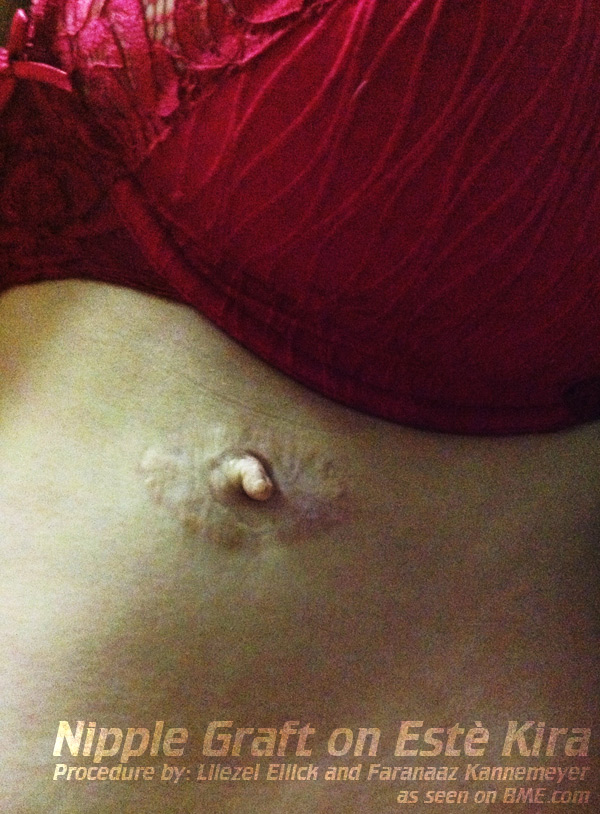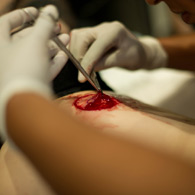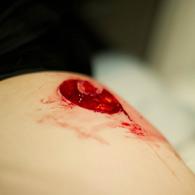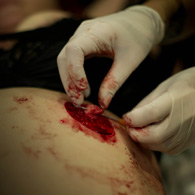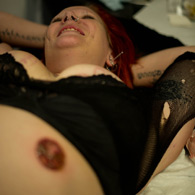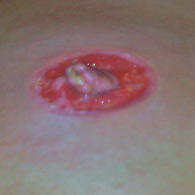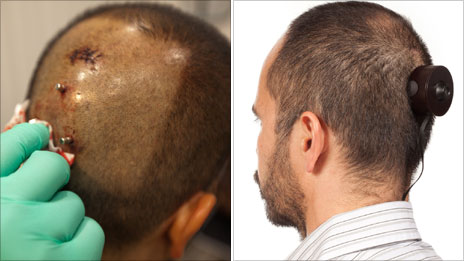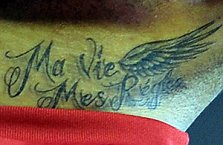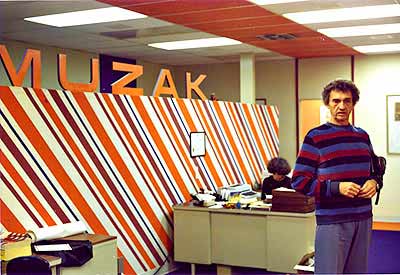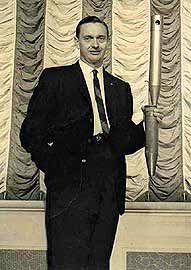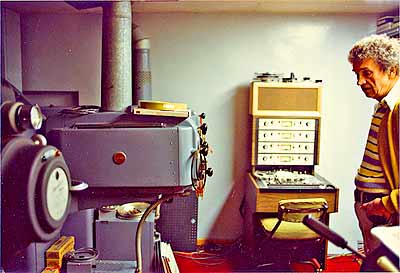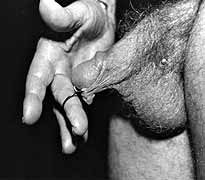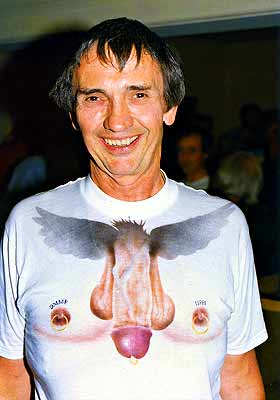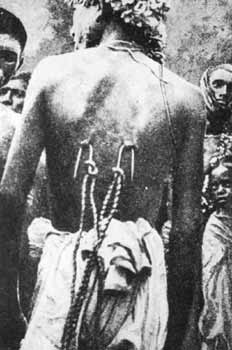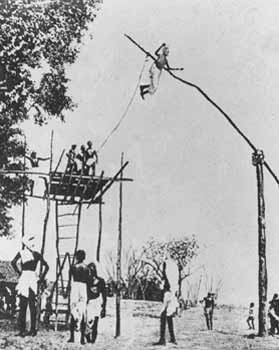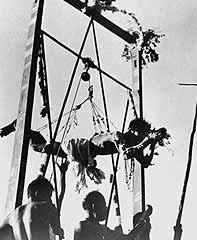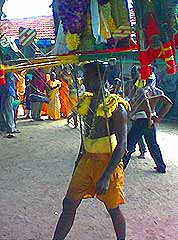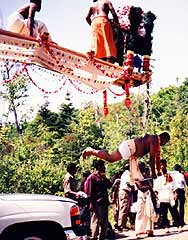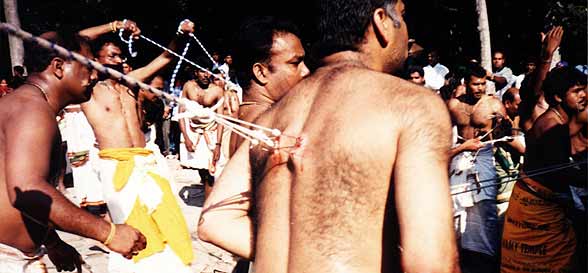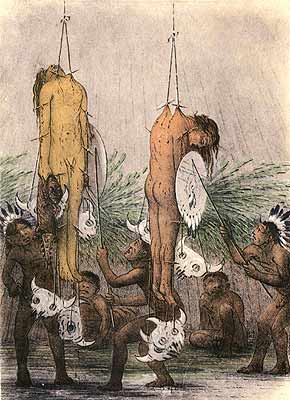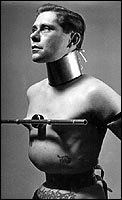|

“Paul Oneball”
My friend Paul — “Paul Oneball” — has been a body modification enthusiast for his entire life, but a few years ago discovered he had cancer, which due to complications resulted in extensive damage to his genitals as well as the loss of a testicle. During the process of healing, he discovered the underground world of silicone injection, which he used to reconstruct his scrotum. His shaft was too scarred to accept silicone, but he’s become an active enthusiast and promoter of silicone work as the moderator of an online discussion group for men interested in injection. His story is an excellent example of the therapeutic and healing value of body modification.
I’m publishing this interview as an introduction to the lighter end of silicone enhancement — as we chat about a little in this interview, many individuals have pushed themselves much farther and into almost alien territory… Those interviews will follow in the future.
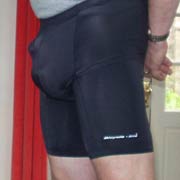 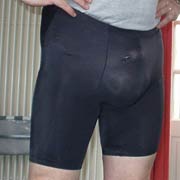
“No wonder that I get some strange looks when I go out on my bike.”
Tell me a little about yourself and how you got into body modification?
I was born in 1954 in the UK on the South Coast and sent off as a child to boarding school, where I was raped by a teacher and moved to another boarding school. I was very interested in body modifications then — from 1970 onwards — but could not find out much about it. PFI Quarterly and Gauntlet later became an inspiration. I did my own PA, and subsequently met Alan Oversby (Mr. Sebastian).
During this time I was training as, and then qualified as a lawyer. I fell in love, married — still am — and started a family. Body modifications were very much in the background. When our family was big enough, I went in for the second commonest male body modification — vasectomy. When the surgeon did the procedure, he found cancer. One ball was lost and I acquired a nasty infection. The end result was an even more drastic, involuntary body modification, which ended in extensive skin grafting (the skin come from my hips). I suppose the effect is rather like that of a radical circumcision — which is basically what they had to do to stop the infection spreading — it was that or amputation.
Did you have much sensation or mobility damage after the grafts?
I have no “skin” feeling along the shaft, although I can fell pressure from the remaining nerves in the underlying tissue. The skin has no mobility it was grafted directly to the base layers in most places.
I came to BME, to see how others coped with semi-castration and so on, and rediscovered silicone. At first I went in for the procedure to replace what I had lost, but it felt so good on me (and still does) that I went back for a little more, and a little more, and now I have 500ccs. My wife is pleased because it’s given me back the confidence I lost. I believe that we need mainstream recognition for the silicone procedure, which is far safer and simpler than the insertion of a prosthesis.
We hear all the time about silicone work being risky — you think it’s safer than a prosthesis, even a simple fake testicle?
Whoever said a prosthesis was safe? All surgery carries risks — as I know all too well. There can be allergic reactions to the “neuticle” unless it is very rigid and smooth, which does not leave a realistic effect. The issue with silicone is the problem of removal if anything goes wrong. If I lose my scrotum, so what? I’ve faced worse.
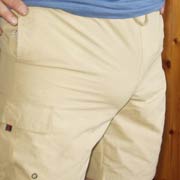
“Whether or not I’m pleased to see you, the bulge stays.”
Let’s go back to the beginning — tell me about when you did your PA?
I did it using a leather punch, twisting a leather bootlace around the handles — like a Spanish windlass — to force the jaws closed through my penis. It worked very well and I wear a 7mm segment ring in the hole. My PA gives me some sensation which I lost due to the grafts. In addition, the PA was very useful for the surgeon doing the skin grafts — it gave him something to grip on to and which could have traction applied whilst the grafts were healing. Luckily the pre-op nurses did not remove it as they wanted to.
What made you want the PA in the first place?
Possibly what I read in the Kama Sutra, together with issues of self-harm after the rape (the perpetrator hung himself). Also, the PA gave me back control — I did this to myself for my own pleasure. From reading other people’s experiences it seems there are quite a few of us in the same boat — going for a modification as a method of resolving a major physical or emotional trauma.
Perhaps that’s true — do you mind telling me more?
I’m referring to the custom of removing digits to express grief, and the self-harm desires of abused kids. Professionally I had a lot to do with boys taken into “care” by the authorities in our area, who were then thoroughly buggered by the guy running the home where they were put. He even sold them on to his cronies. Yuck. A number of these boys were seriously into self harm, body mods, and tattoos — and some found it helped them get back a feeling of control over their bodies, and their lives.
When you had the liquid silicone injected, what procedure was used?
The silicone is put in using a silicone cannula, and is pumped in through an infusion line, so that the syringe pump can be refilled without disturbing the cannula. I have seen a guy take 500ccs in his sack in one go — he already had 500ccs there already — and the result was extraordinary, and a very visible modification. For me, the weight and bulk of the silicone is very pleasing.
    
Have you ever thought about a subincision to expose more nerves?
My wife and and I have looked very seriously at this — she is a veterinary surgeon. The two drawbacks are getting enough skin to heal to the cut edges of the urethra and the probability of bladder infections. I had enough of those living with catheters etc.
What about vacuum pumping to help expand the tissue?
Pumping is a difficult issue because they took out the lymph gland in my left groin as well.
Another guy I’ve been talking to was into complete cock skinning — !!! — and of course was left with an intensely scarred and shortened penis, about 50% of the original length. His approach was far more radical — he would cut strips out of the scar tissue and pull it apart, letting it fill in with additional tissue as it healed [editor’s note: this is an upcoming interview]. Over time, he got back all of the length… Not that I recommend this method, and I doubt everyone could heal from it.
Apart from pumping I had a lot of traction and massage to persuade the skin graft scars to stretch enough to give a reasonable erection. Like I said earlier, this was where my PA really came in useful. The surgeon was very encouraging, but a couple of his juniors were seriously upset about the PA.
I see a lot of silicone guys that go very far with silicone work and really have extremely large genitals that must impact their day-to-day lives to some extent — do you ever worry that you’ll go “too far”? Not that I have a problem with “too far”!
After a lot of heart searching, I feel I have gone far enough with the silicone. Any more will start to affect my everyday life, whilst now I can dress to minimize, as well as maximize, the effect. It is something that the practitioner and I have discussed at length — along with other guys who have visited for silicone. A few conversations come to mind…
One man — we’ll call him Peter — has always had a fantasy from childhood of grossly swollen genitals. Silicone gave him the opportunity, and after the practitioner’s first session, he, Peter, having access to all the kit as a medical professional, has gone further and further, until now he is impinging on his working life. He is happy though that he has achieved his obsessional fantasy, and his genitals are forever swollen, to a massive extent — he carries well over 2000 ccs. Mark Savage (www.siliconefreak.com) has set out to go to the extreme. Now he cannot hide what he has done and uses it as a selling point — he is in the sex trade. He cannot use his penis for penetrative sex.
Last night I was having dinner with three guys. Two had been siliconed, and one wanted to go further, but his boyfriend who didn’t have any silicone was against this as he felt it would be cutting down his partner’s options. By all means be big, so big that it would be obvious in intimate situations, but do not go so far that it might prejudice the non-sex side of life and relationships. This is the attitude I have — any more and I might embarrass my sons (not that I don’t embarrass them already) and prejudice everyday life. I couldn’t care less about respectability, but extreme silicone, like facial tattoos, can cut down life options.
As a lawyer, how do you feel about practitioners doing procedures that — such as silicone work — that may not be legal for them to perform?
The concepts of underground and legal are difficult ones. My view was — 25 years ago — that if the “victim” was legally capable, was aware of what was being done, and freely consented, then, provided no prescription-only medicines were used, any procedures would be legal. That was before the infamous Operation Spanner. [Editor’s note: in short this involved men being charged with assault over consensual sex and modification play.]
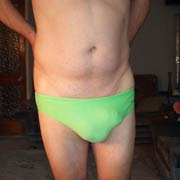 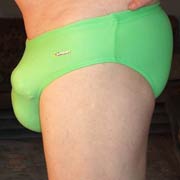
“It really does stick out — and this is forever — the choice I’ve made.”
How should both practitioners and the people seeking procedures protect themselves and take steps to make sure everything is trouble free?
Discretion seems the wisest course. As long as what is being done does not come to the direct attention of the authorities through death, serious long term consequences, or dealings with minors, incapables, or those under duress, and no attempt is made to assume false medical qualifications, the practitioner should be safe enough. Consent forms or correspondence are helpful, but are no substitute for common sense. The infamous “Doctor Brown” was put away for sawing some poor guy’s leg off. Alan Oversby was convicted for sending “obscene” pictures — one of them was of me — through the Royal Mail.
What is the legality where you are?
The procedure is “legal” in the UK and Europe. In France, Holland, and Germany it is an accepted but not advertised, procedure. I know one Dutch doctor, and one German who will do the procedure reluctantly… Usually there is a quid pro quo, which I find ethically dubious.
Who do people go to for the procedures, and how do they find them?
The only one in the UK is not a doctor at all, but a materials scientist, who sourced the silicone and has worked out a method of sterilization that actually works. Word of mouth and referral by people through the online groups are the usual ways.
Since the skin on your shaft was grafted right to the underlying tissue, I assume you were unable to do silicone in the shaft?
Absolutely correct — the skin was grafted directly to the smooth muscle of the shaft, which had ended up buried in my pubis after the infection destroyed the original skin structure.
How did your doctors respond to your silicone work?
My GP is very positive about the procedure — and has made serious inquiries with a view to making it a serious alternative to the implant of prostheses (false balls or neuticles).
Did you approach them about it before going with an underground practitioner?
Because of the possibility of the infection flaring up, further surgery to insert a prosthesis was not advised. My GP did not feel that I had much to lose over the silicone procedure, although he warned me about the issues of infection and hardening, from work done on this topic in France.

All in all, how do you feel about the modifications you’ve done?
I find my mods enjoyable and satisfying.
Thanks for chatting, Paul!

Shannon Larratt
BME.com
|
